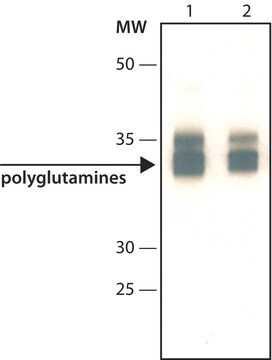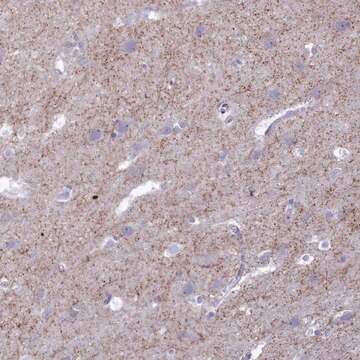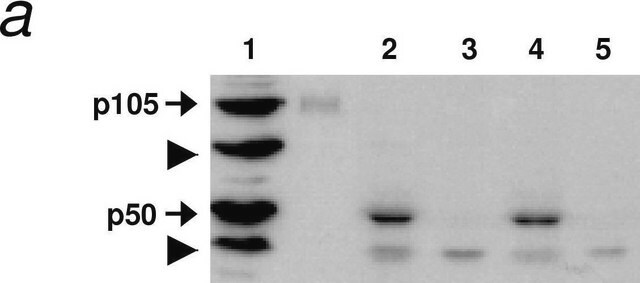おすすめの製品
由来生物
mouse
品質水準
結合体
unconjugated
抗体製品の状態
purified antibody
抗体製品タイプ
primary antibodies
クローン
5HU-1H6, monoclonal
分子量
calculated mol wt 347.6 kDa
observed mol wt ~350 kDa
化学種の反応性
human
包装
antibody small pack of 100 μg
テクニック
immunocytochemistry: suitable
immunofluorescence: suitable
immunohistochemistry (formalin-fixed, paraffin-embedded sections): suitable
western blot: suitable
アイソタイプ
IgG1κ
エピトープ配列
N-terminus
タンパク質IDアクセッション番号
UniProtアクセッション番号
輸送温度
dry ice
ターゲットの翻訳後修飾
unmodified
遺伝子情報
human ... HTT(3064)
詳細
特異性
免疫原
アプリケーション
Evaluated by Western Blotting in lysates from HEK293 cells transiently overexpressing Huntingtin protein.
Western Blotting Analysis (WB): A 1:250 dilution of this antibody detected Huntingtin in lysates from HEK293 cells transiently overexpressing Huntingtin protein.
Tested Applications
Western Blotting Analysis: A representative lot detected Huntingtin protein in Western Blotting application. (Miller, J.P., et al. (2010). Neuron. 67(2):199-212; Lunke, A. et al. (2002). Mol Cell. 10(2):259-69; Ratovitski, T., et al. (2007). Cell Cycle. 6(23):2970-81; Michels Thompson, L., et al. (2009). J Cell Biol. 187(7):1083-99; Juenemann, K., et al. (2011). Neurotox Res.;20(2):120-33).
Immunohistochemistry Applications: A representative lot detected Huntingtin protein in Immunohistochemistry application. (Lunke, A. et al. (2002). Mol Cell. 10(2):259-69).
Immunofluorescence Analysis: A representative lot detected Huntingtin protein in Immunofluorescence application. (Juenemann, K., et al. (2011). Neurotox Res.;20(2):120-33).
Immunocytochemistry Analysis: A representative lot detected Huntingtin protein in Immunocytochemistry application. (Miller, J.P., et al. (2010). Neuron. 67(2):199-212; Lunke, A. et al. (2002). Mol Cell. 10(2):259-69).
Note: Actual optimal working dilutions must be determined by end user as specimens, and experimental conditions may vary with the end user
物理的形状
保管および安定性
その他情報
免責事項
適切な製品が見つかりませんか。
製品選択ツール.をお試しください
保管分類コード
12 - Non Combustible Liquids
WGK
WGK 2
引火点(°F)
Not applicable
引火点(℃)
Not applicable
適用法令
試験研究用途を考慮した関連法令を主に挙げております。化学物質以外については、一部の情報のみ提供しています。 製品を安全かつ合法的に使用することは、使用者の義務です。最新情報により修正される場合があります。WEBの反映には時間を要することがあるため、適宜SDSをご参照ください。
Jan Code
MAB5490-I-100UG:
MAB5490-I-25UG:
試験成績書(COA)
製品のロット番号・バッチ番号を入力して、試験成績書(COA) を検索できます。ロット番号・バッチ番号は、製品ラベルに「Lot」または「Batch」に続いて記載されています。
ライフサイエンス、有機合成、材料科学、クロマトグラフィー、分析など、あらゆる分野の研究に経験のあるメンバーがおります。.
製品に関するお問い合わせはこちら(テクニカルサービス)






